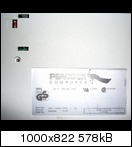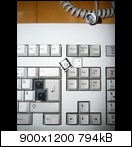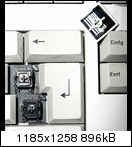JBert wrote:Ah yes, those are indeed vintage Cherry MY switches. I have two keyboards with them, but they are just way too stiff for my taste. They can be considered "mechanical" but they offer only a linear feeling (it's just two springs pushing the key up, no extra friction like the MX switches).
They are compatible with a modern PC, given that you have a PS/2 to AT adapter (a cable or thingy with both the large AT connector and a PS/2 connector). If your computer has a PS/2 port, you could then plug it in directly, or you could buy a PS/2 to USB converter (a little electronic device with a PS/2 connector and an USB connector, it should contain a chip though).
You do want to consider if it's worth buying this cable and adapter though, as the MY isn't the best keyboard out there. They are sturdy and reliable, but the stiffness just kills it for long typing sessions.
These keyboards are mostly prized nowadays for their special keycaps (double-shot) which have the legends embedded in the plastic, rather than being printed on top of the keycaps when the keyboard is finished. Check the backside of the keycaps, you can clearly see that it is made out of grey and black plastic.

I thought these might be vintage Cherry MX blacks or something.

It really got my hopes up as I stumbled upon the "Dating Cherry keyboards" thread (
http://geekhack.org/showwiki.php?title= ... old+models) on geekhack, because I thought that "HAD" would correspond to "two-shot injection molded, MX black and German layout", while "F19" in the serial number would indicate a production year of 1993. Oh, and another thing: How are additional labels on double-shot keycaps done? I think I saw some green lettering on, for example, the front of the "Pause" key. Are these only printed on the key caps?
Then what does this red switch (first picture) do? Or is this something that is not common for older keyboards? Are these boards at least better than normal rubber domes?

Because then I might buy such an adapter, since I found some for about 5 € and my new PC (which, more or less, is the reason for my desire for a new keyboard) still has a PS/2-port.
Mmmh, I should probably just win a new keyboard via voting for the Deskthority Awards.

Half-Saint wrote:What a coincidence! I recently also stumbled upon a PEACOCK keyboard using the exact same switches. Mine looks a lot like a G80-1000 but the bottom of the case is different. There is also no Cherry branding anywhere on the case. Keycaps are dobuleshot just like yours.
Cheers
And these really are vintage MY switches? Given that, they really changed their appearance a lot (from "closed" and black to "open" and white), I think.
kbdfr wrote:As a matter of fact it appears not to be an uncommon brand, here is another one for sale on eBay:
http://cgi.ebay.de/ws/eBayISAPI.dll?Vie ... 0864397643
I have one in the older 1000 version, also with old-style MY switches and thick doubleshot keycaps.
No label at all (has obviously been removed).
This being said, if you want to gain experience with mechanical keyboards, MY switches are not really what you would need. Grab a cheap MX board and you'll feel the difference at once.
MX blacks are my favorite switches for typing precisely because they are linear and have a higher actuation force than others.
- I hold tactile response from the keys to be more a gadget, because at normal typing speed you couldn't "wait" for the response before you proceed to the next key, so in fact you would have typed several more characters already before you "miss" the tactile response of a not actuated key. And you would probably have already "missed" the character on the screen anyway (touch typing normally implies your eyes wandering between the screen and whatever document you are working on, if any).
- I want my keyboard not to react at once when I rest my fingers on the keys. I do not use a wrist rest when typing (it would just slow me down), so when I actually stop typing (for example when thinking about formulating the next sentence or when waiting for an audio file to keep up with my typing speed) I position my fingers on the home row (and sometimes on the arrow or numpad keys) and of course do not want to have to lift my fingers in order to prevent the switches from actuating. And of course, the force I need when typing keeps my fingers trained also for other tasks (like playing a music instrument).
I keep contending blacks are the best choice for professional typing (which I have been doing for years), but this seems to be a minority opinion. In any case, any MX switch is better than a MY switch.
OK, but where do I get such a cheap MX board (German, or at least ISO) from? Are these G80-1800s described in the thread "Cheap linear boards" in a good condition? The online shop looks a bit "shady"...

Or do you know where I could get another cheap MX board in Germany? I think if I knew which switch I liked, I would just buy a new G80-3000XY, since they are quite cheap (in Germany) for a new mechanical. But I read their build quality might be an issue. Is that valid or only in comparison to, I don't know, >150 € mechanicals?
So, if I wanted a switch with a tactile response, I should look for MX clears and MX blues would be too soft? Somehow, I think I might like some kind of tactile response, since I think it might be quite hard to not bottom out linear switches if you do not have any experience with keyboards other than rubber dome keyboards, where you have to bottom out of necessity to actually trigger anything. Since I am rather sensitive towards loud noise, at least when I want to concentrate, a keyboard that is too loud (because of me or the keyboard itself) would be somewhat a deal breaker for me, I think.



